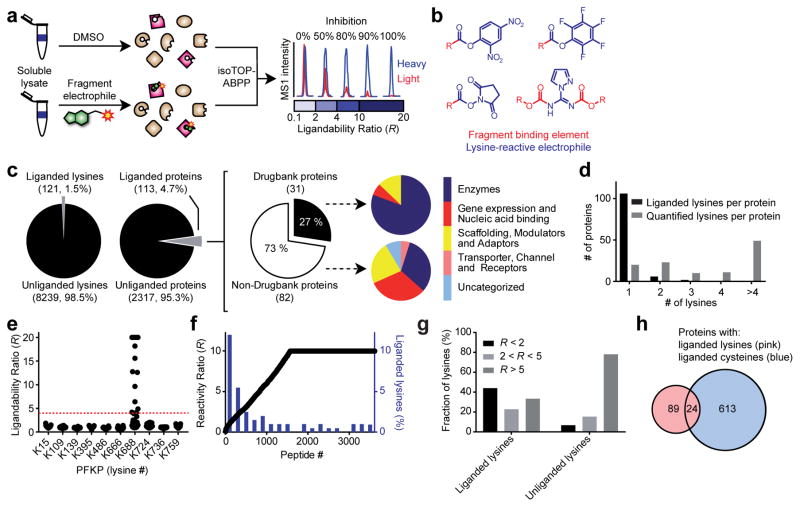Figure 3.
Proteome-wide screening of lysine-reactive fragment electrophiles. a, General protocol for competitive isoTOP-ABPP. Competition ratios, or R values, are measured by quantifying the relative MS1 chromatographic peak intensities for 1-labeled peptides in DMSO- (heavy, or blue) versus fragment-treated (light, or red) samples. An R value of ≥ 4 was used to define a fragment liganding event for a quantified lysine. b, General structures of a lysine-reactive, electrophilic fragment library. See Supplementary Fig. 4 for chemical structures of library members. c, Fraction of total quantified lysines and proteins that were liganded by fragment electrophiles (left panel); of the liganded proteins, the fraction that is found in Drugbank (middle panel); functional classes of liganded Drugbank and non-Drugbank proteins (right panel). d, Number of liganded and quantified lysines per protein. Analysis was applied to proteins containing at least one liganded lysine. e, R values for ten lysines in PFKP, identifying K688 as the only liganded lysine in this protein. Each point represents a distinct fragment-lysine interaction quantified by isoTOP-ABPP. The red dashed line marks an R value of 4 used to define a fragment liganding event. f, Comparison of the ligandability of lysine residues as a function of reactivity with probe 1 (as measured in Fig. 1). Individual lysines are plotted on the x-axis sorted by reactivity, which is shown on the left y-axis, with lower R values correlating with elevated reactivity. A histogram with a bin-size of 200 is shown in blue for the percentage of liganded lysines within each reactivity bin (percent values shown on the right y-axis). g, Lysine reactivity distribution for both liganded and unliganded lysine residues labeled by probe 1. h, Overlap of proteins harboring liganded lysines and liganded cysteines. Cysteine ligandability was taken from reference 10.

